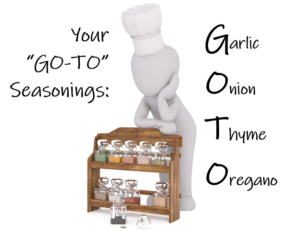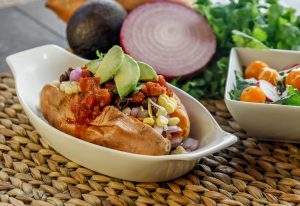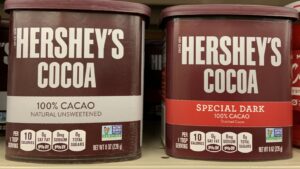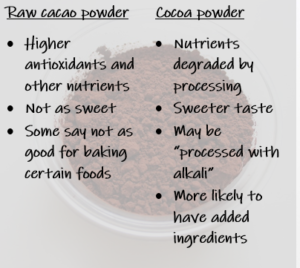 Do you have questions as you progress on your REAL food journey?
Do you have questions as you progress on your REAL food journey?
Trust us, you’re not alone!
We thought our weekly coaching tips would be the perfect opportunity to periodically answer some of the questions we are frequently asked. We will continue to do this if you find it is useful, so please share your thoughts and questions!
Let’s dive in with our first round of frequently asked questions:
What spices should I buy and where should I buy them?
As you know, spices and seasonings are key in transforming REAL ingredients into delicious meals. In addition to salt and pepper, the dried spices we use most often, and can’t live without, include:
 Garlic (granulated garlic or garlic powder)
Garlic (granulated garlic or garlic powder)- Onion (granulated onion or onion powder)
- Thyme (dried thyme leaves)
- Oregano (these first four seasonings are the ingredients for our “GO-TO seasoning“)
- Basil
- Cinnamon
- Cumin
- Curry powder
- Dill (dill weed)
- Nutmeg
- Red pepper flakes
- Rosemary
- Smoked paprika (and regular paprika)
- Turmeric
- Zaatar
You can make magic happen with these staple spices!
We typically buy our spices from a local store called The Spice Merchant. We can purchase the quantities we want and feel like they are a little fresher and more flavorful and affordable than the ones we get at the grocery store. Please know, there is nothing wrong with buying spices from your local store – do whatever is easier for you. We always have a mason jar filled with our “GO-TO” seasoning mixed and ready for roasting vegetables. We also have mason jars of homemade seasoning mixes like taco, Jamaican jerk, blackened, and Cajun. And we typically keep our spices and seasonings in the pantry (a cool, dark place). Our Kick the Packet to the Curb coaching tip provides more information on this topic.
What meal ingredients do you have on hand all the time?
(You know, for those nights when you don’t have a plan and didn’t have time to go to the store?)
First, we really try to avoid this situation by having a plan when we go to the store and stock up on ingredients for a few meals. Like everyone, life happens sometimes, and we have to come up with a meal on the fly. There are a few meals we virtually always have the ingredients on hand for, including:
 Southwest Stuffed Sweet Potatoes. It is super-easy to cook the sweet potatoes in the microwave (if I forgot to put them in the slow cooker), and then quickly sauté the filling using black beans, corn, red onion, and a couple seasonings. Put it all together and add your favorite toppings like salsa, avocado, cheese and cilantro. Voila, dinner! This is also great to take to the ball fields or other times when you are on the run.
Southwest Stuffed Sweet Potatoes. It is super-easy to cook the sweet potatoes in the microwave (if I forgot to put them in the slow cooker), and then quickly sauté the filling using black beans, corn, red onion, and a couple seasonings. Put it all together and add your favorite toppings like salsa, avocado, cheese and cilantro. Voila, dinner! This is also great to take to the ball fields or other times when you are on the run.- Roasted Vegetable Pesto Pasta. Cook some whole grain pasta, roast whatever vegetables you have on hand, and put them together with some homemade or jarred pesto or some jarred marinara sauce. So simple and barely even requires a recipe! You could also use hearts of palm pasta (no cooking required). Another good one to take on the run.
- Simple Savory Tuna Melt. Combine a couple cans of tuna with a little red onion, olive oil, balsamic and a few seasonings. Then add a little mayo, mustard, cheese and pickles for a delicious quick and easy sandwich!
We also make it a practice to NEVER run out of staple ingredients like dark leafy greens, a variety of fresh vegetables, nuts and seeds, fresh and dried fruits, whole grains like oats, farro, quinoa and rice. With these ingredients always on hand, it is very easy to throw together a delicious salad, a veggie-loaded stir-fry, or a flavor-loaded Buddha bowl. If you are interested in reading more about staples that we always try to keep on hand, check out our coaching tip Extreme Home Makeover: Pantry Edition.
How do you store nuts? In your pantry?
 We actually store nuts in the refrigerator. This is because we often buy our raw nuts (like almonds, pecans and walnuts) in bulk and storing them in a cool, dark place helps keep the fats from deteriorating. You could also store them in the freezer to extend their freshness even longer. This is a good idea for toasted nuts, as the heat prompts the oils to begin oxidizing and they will go rancid more quickly. If you buy them in smaller packages and use them within a week or two, storing them in your pantry should be fine.
We actually store nuts in the refrigerator. This is because we often buy our raw nuts (like almonds, pecans and walnuts) in bulk and storing them in a cool, dark place helps keep the fats from deteriorating. You could also store them in the freezer to extend their freshness even longer. This is a good idea for toasted nuts, as the heat prompts the oils to begin oxidizing and they will go rancid more quickly. If you buy them in smaller packages and use them within a week or two, storing them in your pantry should be fine.
We find bulk nuts to be significantly more affordable than the smaller packages. For example, we buy bulk almonds from Sam’s Club for about $10 for three pounds (48 oz). That’s just under $0.21 per ounce. If we bought them at our local grocery store, they would be $7 for 16 oz, or almost $0.44 per ounce. The Sam’s Club package lasts us several weeks and we have never had them go bad keeping them in the fridge.
For more on nuts, check out these coaching tips: Are You Nuts? and Grocery Shopping is Nuts!
Is Hershey’s cocoa the same as baking cocoa?
Read the ingredients and look for just one ingredient: cocoa. Make sure the ingredients don’t say, “processed with alkali,” as this dramatically reduces the nutritional content. Hershey’s makes one version that is simply “cocoa” and another version called “Special Dark 100% Cacao” that is processed with alkali.
Sneaky, right?
The longer answer: In our coaching tip, Is there a difference between cocoa and cacao?, we dive into this topic. The one thing all chocolate has in common – it starts with cacao beans. These beans are then fermented, dried, and go through a variety of processing to turn them into nibs, powder, and all kinds of chocolate products. We like to think of cocoa powder in three categories:
 Raw cacao powder. This is made before the beans are roasted, thus retaining the most nutrients. The roasting process is when antioxidants and other nutrients start to decrease. Raw cacao powder can be purchased on Amazon or a stores like Natural Grocer or Whole Foods and is sold by companies like Navitas Organics and NOW Foods.
Raw cacao powder. This is made before the beans are roasted, thus retaining the most nutrients. The roasting process is when antioxidants and other nutrients start to decrease. Raw cacao powder can be purchased on Amazon or a stores like Natural Grocer or Whole Foods and is sold by companies like Navitas Organics and NOW Foods.- Cocoa powder. This is the most common one available in most grocery stores. For these products, the beans have been roasted, which deepens their chocolate flavor and adds some sweetness. Then, after being roasted, they are crushed and ground, producing a non-alcoholic “chocolate liquor.” This liquor is then pressed to remove the fat (which is called “cocoa butter”), and then what is left can be processed into cocoa powder. Although cocoa powder isn’t the same nutrient powerhouse as raw cacao powder, it is still a good choice. The key is to look at the ingredients and make sure it is 100% cocoa – and there should be no added sugar. Hershey’s makes one where the only ingredient is “cocoa.”
- Cocoa powder processed with alkali or with added sweeteners. When cocoa is processed with alkali (or “Dutch processed”), it has been processed in a chemical solution to enhance its color, reduce its bitterness and give it a smoother texture. Unfortunately, this also dramatically reduces the nutritional content of the chocolate (by as much as 90%). Hershey’s is sneaky when they sell their “Special Dark 100% Cacao” powder. Sounds healthy, right? If you look at the ingredients, you will see it is “cocoa processed with alkali.” There are also sweetened versions or cocoa powder that are loaded with sugar – for example, Ghirardelli makes a sweetened cocoa powder where the ingredients include sugar and cocoa processed with alkali – it has a whopping 27 grams of added sugar in a 3 Tbsp serving. Another reason to always read those ingredients!
How do you come up with the recipes on Eat REAL America?
When we decide we want to add a new recipe to the website, we research what others have done and what worked and didn’t work. Then, we take this information to develop our recipe. We focus on making sure the recipes are nutritionally balanced, which often involves cutting the sugar and salt while amping up the seasonings and spices compared to recipes we find on the internet. We also try to simplify the recipes to reduce the number of steps and making cleanup easier (why dirty multiple pans if you can cook everything in one pot?). We are now at about 80% of our recipes being “website worthy” with our first attempt. (Let’s just say, we have learned a lot over the years!) Of course, we take our own photo, and then add the recipe and the nutritional info (thanks to Zonya and her team) to the website.
 For the 20% of recipes that are not website worthy and don’t make the cut (often because they just don’t have that “WOW” flavor factor), we head back to the drawing board, make some adjustments, and try again.
For the 20% of recipes that are not website worthy and don’t make the cut (often because they just don’t have that “WOW” flavor factor), we head back to the drawing board, make some adjustments, and try again.
For example, an Eat REAL America member recently asked us if we could come up with a healthy Chicken & Dumplings recipe. Our first attempt was an epic “failure” – the flavor was blah! and there was too much work involved in making the dumplings, which were healthier but too dense. We came up with the idea of using gnocchi for the dumplings, and then adding them to a flavorful, slightly creamy chicken soup. Winner winner chicken dinner – it was really delicious! Look for the recipe on the website later this week!
Remember, for a recipe to be website worthy, it has to be easy to prepare, great-tasting, affordable and good for you. Our goal is to make it taste so good you don’t even realize you’re eating healthy!
And, our inspiration for new recipes comes from our travels, in-season ingredients, and from YOU! If you have a recipe you want us to try to transform into something healthy and delicious, please let us know – we will give it our all! If you are interested in reading more about what we have learned about cooking, online recipes, nutrition, cravings and more, check out this coaching tip.
We hope these FAQs are helpful!
Ask us your questions and we will try to answer them in future “Ask Us Anything” coaching tips!






Love this information!! Thanks!
Thank you for the feedback – we are so glad you thought it was helpful!
Any way to make “Fried” onions?
Great question Linda! We have the recipe for the Healthified Bloomin’ Onion, https://eatrealamerica.com/recipes/healthified-bloomin-onion-with-spicy-dipping-sauce/, but we will get some testing started for other ways to make fried onions healthier and keep you posted! Thank you!
Wondered what brand zatar to use
Diana – Since we typically buy Zaatar from a local spice store, it really doesn’t have a “brand” but I would say whatever brand that is available at your local store should work great. Keep us posted what you think of it, we love Zaatar in many mediterranean recipes and especially on roasted veggies with a little olive oil, salt and pepper!
Great article!! thanks- Greg
Just last night we heard that brown rice has been found to have arsenic in it. Have you heard this too? We’re wondering how often it can be safely eaten and if there is any way to tell how much arsenic is in the brands we buy? Do producers have to disclose this?
We have become concerned about using olive oil to sauté as we’ve recently been told that olive oil can easily turn to trans fat if the frying temperature reaches a high point, which supposedly is easy to do in the home kitchen. That we should reserve olive oil for low temp or cold uses, like salads. Is there then a better choice for frying such as avocado oil, coconut oil or ghee? Or does the saturated fat in these become the greater problem? How much fat can be safely consumed before cholesterol is raised?
Bev – These are great questions and concerns, and so glad you asked. Regarding the rice, we address this issue in our If Rice Could Talk coaching tip (https://eatrealamerica.com/2023/08/if-rice-could-talk/) so you might check it out to clear up some of the confusion, it comes down to knowing where your rice is coming from.
And then regarding the extra virgin olive oil, there really is a lot of confusion out there! We have a coaching tip on oils, which includes a grocery store tour. https://eatrealamerica.com/2021/06/oils-not-created-equal-2/
Just remember that extra virgin olive oil (and read the ingredients to make sure that is truly what you are getting) has huge health benefits, which is why we recommend it often and why it is a staple in the Mediterranean diet. We use extra virgin olive oil in our sautéing, roasting, salad dressings, etc. Zonya just mentioned in one of her courses that when we call for other oils like coconut oil, they are in such minimal amounts that the saturated fat in these recipes should not raise concern. And, most of the time you can even substitute extra virgin olive oil in these recipes too, although sometimes the coconut oil will help hold ingredients together such as in the Chocolate Chia Energy Bites, https://eatrealamerica.com/recipes/chocolate-chia-energy-bites/.
Thank you again for asking and please let us know if you have more questions!
Some members of my family,and myself, are dairy-free and egg free, (not by choice). My question is what can be used instead of butter since every vegan alternative I’ve seen is full of chemicals. Thanks
Lisa – Thank you for asking, I would just substitute extra virgin olive oil where you might be using butter now. We rarely call for butter in our recipes, and when we do, in most cases you could swap it out for oil. (In some of our sweet treats, you could use coconut oil instead.) If we have toast, we typically don’t use butter, but instead will spread some avocado or natural peanut butter, depending on how you are enjoying it. Does that help? Thank you!
It looks like you use sweet potatoes in many of your recipes. I know they have a lot of sugar, and I don’t really like them. Is a white or red potato a good substitute or do you have another suggestion? Thanks!
Kimberly – Thank you for asking, we hear this quite often, that people think they don’t like sweet potatoes! When it comes to sugar, actually sweet potatoes, and potatoes in general, are perceived to cause a spike in blood sugar and a surge in insulin. What is fascinating about sweet potatoes is they can actually help regulate blood sugar levels. This is because of the fiber and other nutrients that help steady the pace of digestion and release sugar slowly into the bloodstream (vs. the spike that many fear). Eating potatoes with proteins and healthy fats will also reduce the glycemic load of your meal! You can see more about this in our coaching tip on sweet potatoes. I would encourage you to try sweet potatoes in different ways, a couple of our favorites are the Southwest Stuffed Sweet Potato and Seasoned Roasted Potatoes and Brussels Sprouts (the GOTO seasoning in this recipe is the secret to flavor loaded veggies – garlic, onion, thyme and oregano!) I hope that helps – we have transformed a lot of people to now love sweet potatoes with these 2 recipes! Please keep us posted and let us know what you think – thank you!